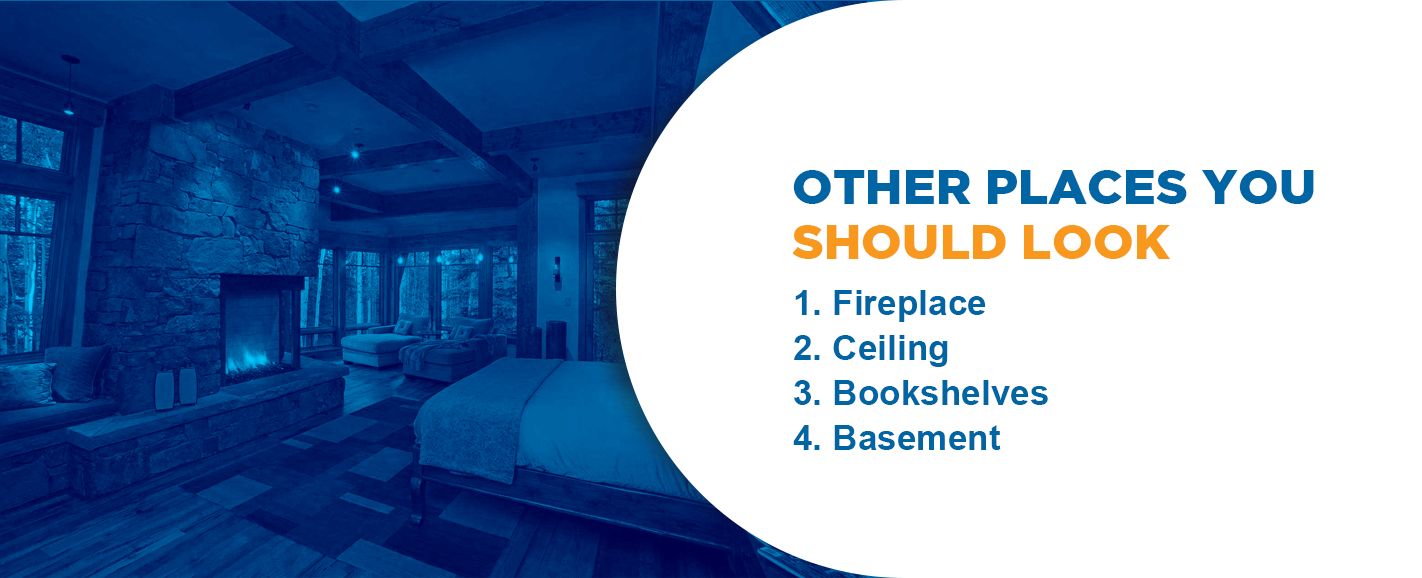What Can I Do If One of My Rooms is Always Cold?
If there is a cold room in your house, the problem has likely been caused by dirty vents, cracked ductwork, worn insulation or faint drafts. Read on to learn how to fix a cold room in your home.
Check for Simple Problems

If one room in your house is colder than the rest, the first things to inspect are the heating vents, ductwork and thermostat readings. Inspections of this sort should be performed at least once yearly.
If your room is cold you might need to:
- Check heating vents
- Clean vents
- Test the thermostat
- Test the temperature
- Consider the ductwork
1. Check Heating Vents
Inspect each of the heating vents around your house. If furniture covers a vent, move the furnishing out of the way and, if necessary, rearrange the room to accommodate this change and do the following:
- Examine the outer grates for signs of dust or gunk buildup.
- If the grates are dirty, clean them.
- If the grates do not appear dirty, remove the duct cover to inspect the inner vent.
If dirt lines the inner vent, that could be the problem. If you see rodent droppings or a rodent carcass, you have an infestation problem and should call your exterminator immediately. Take a flashlight to the vents for deeper inspections. You can also get a better idea about the state of your vents by reaching inside and taking photos with your smartphone.
2. Clean Your Return Air Vents
The passage of heat could possibly be obstructed by dust and gunk in the air vents. To clean out the vents, do the following:
- Shut off your HVAC system and unscrew the duct covers from your walls.
- Clean out the grates of each duct thoroughly. If necessary, use soapy water or cleaning spray.
- Take a vacuum hose and clean out dust from the air ducts and also vacuum over any crevices.
Apply a similar set of steps to the grates on your ceiling, but cover your floor with newspaper and wear a dust mask to make sure that no dust lands on your floor or face.
3. Test the Thermostat
If the thermostat reads the heat incorrectly, it can be difficult to adjust your rooms to the desired temperature. To test the thermostat for accuracy, tape a thermometer onto your wall next to the thermostat reader and leave it there for 15 minutes. When you do this, place a paper towel behind the thermometer to prevent the transfer of hot or cold wall temperatures. The purpose here is to determine the room temperature.
Check the two readings after 15 minutes. If the thermostat reader and thermometer are more than one degree off from one another, you may have a faulty thermostat.
4. Test the Temperature of Your Walls
If one wall in your home is far colder than the others during winter, the problem might have less to do with your heater and more to do with degraded insulation. You could purchase new insulation and have the wall cavities re-stuffed, but you would need to remove the interior plasterboard to complete these steps.
The easiest way to re-insulate your walls is to spray foam insulation into the wall cavities. Spray foam insulation expands to fill small gaps and enclosed spaces. You can apply spray foam insulation into each wall cavity through small holes in your wall. Most spray foam insulation is a non-intrusive substance that can easily be cut away when necessary.
5. Consider the Ductwork
If select rooms in your home feel under-heated, there could be leaks in the ductwork. The problem could be limited to one or two rooms or spread throughout your house. Depending on how many vents you have, it could be a problem with one weak vent, insufficient venting or a more widespread problem with the ductwork.
The easiest and least costly way to salvage cracked ductwork is with the use of a gap-sealant product, such as an aerosol polymer spray. When applied to the inside of the ducts, the polymer lines the interior walls and seals up duct cracks.
Make Sure It Is Not Your Windows or Doors
Why is one room in my house so cold? The answer to that question could reside along the edges of your door and windows. Check around the window panes and door jambs to make sure that no drafts are present.
Apply Rubber Sealing to Your Window
If your windows are leaking air, the problem could put a drain on your insulation and a strain on your heating bills. To verify the problem, carefully flick a lighter or hold a lit candle along the edges of your windows. If the flame blows sideways, you have a leaky window seal.
The easiest and lowest-cost remedy for air leaks in window seals is the use of rubber sealing strips. Buy strips from your nearest supplier and cut the rubber into strips that span the vertical and horizontal measurements of the window seals. Apply the strips along the left, right, top and bottom edges of each loose window.
Consider Glass Insulation Film
Another way to salvage a weakening window is to reinforce the glass with an insulation film, which adheres to window panes and makes the glass stronger and the seals more air-tight. You can buy insulation film from most hardware stores. With insulation film, you can postpone an investment in a new set of windows and temporarily increase the quality of older windows.
Insulation film adheres to glass with heat. Use a hair dryer to apply the film to the full spread of each glass pane. Follow the instructions that come with the film carefully to avoid wrinkles.
Tighten the Door Hinges
The front door to your house could also be the spot of an air leak, especially if the hinges are loose and the door shuts slightly ajar. To test for an air leak, run the palm of your hand up and down along the vertical sides of the closed door from the inside. Alternately, you can try the candle trick.
If you feel a draft or the flame turns sideways, you have a loose upper hinge. Tighten the upper hinge and test the sides again to see whether there is still a draft. If you still feel a draft, apply weather stripping along the vertical sides of the door. If the door was built within the last few decades, you might need to remove old stripping first. If the door is older, it might lack stripping altogether.
Install or Replace a Door Sweep
Cold air can easily come in from the outside if there is any gap between the bottom of your front door and the threshold. To verify whether a gap exists, check for light coming in from the outside. Alternately, stand barefoot before the door to see if you can feel a draft. If so, it might be time to replace the door sweep.
Measure the horizontal width of your door and select a new sweep of suitable length. Follow the instructions that come with the product to apply the sweep to the under-edge of the door. A strip of door sweep will not work if the flooring in the entrance rises above the threshold in front of your door.
Replace the Door Stripping
The stripping along your vertical door jambs can get damaged from age, wear, pets or nicks. If cracks appear along the stripping, drafts can easily leak into your rooms. Inspect the stripping from top to bottom to determine whether the door is in need of new weather stripping. You can choose from hard or soft stripping types. To replace your stripping, do the following:
- Measure the vertical and horizontal lengths of the door and purchase your replacement stripping.
- Remove the old stripping from your door.
- Apply stripping along the top horizontal jamb.
- Apply stripping from top to bottom within the grooves along the vertical jambs of your door.
Make sure to install the stripping tightly, or it might obstruct your door.
Other Places You Should Look
If cold air sources cannot be traced to your ductwork, windows or doors, consider the possibility of a draft from your fireplace or poor insulation in your attic or basement.

Fireplace
If cold air is leaking into your house through the fireplace, you can rectify matters by adding ceramic insulation around the chimney. When the fireplace is not in use, the easiest way to prevent inward drafts of air is with inflatable fireplace plugs. A fireplace plug is in inflatable, plastic pillow that you insert up the chimney with a standing rod. When you wish to use the fireplace, simply remove the plug and set it aside.
Ceiling
Heat could possibly leak upward and out your house through the ceiling, in which case the insulation could be worn, insufficient or absent. To apply new insulation, you may need to remove any floorboards in your attic to access the joists. Turn off all electrical lines that run along the ceiling. Measure the width between the joists and cut your new insulation down to suitable lengths and widths. Fill each gap from side-to-side with thick sheets of replacement insulation. Be careful to avoid light sockets or outlets as you apply the new insulation. Reattach the floorboards. If you are up for the task, you can perform these steps yourself though it is usually advisable to hire a home-improvement specialist.
Bookshelves
If one of your living areas features a recessed bookshelf, there could be an insulation problem lurking in the wall cavities around the shelving structure. If a poor smell has developed in that part of your home and you have not been able to trace its source or remedy the problem with air fresheners, the insulation surrounding the shelf may have developed mold due to condensation.
If the area around the bookshelf has also been one of the coldest spots in the house, poor insulation is the likeliest culprit. Have the insulation inspected and replaced or reinforced if necessary.
Basement
If not adequately insulated, your basement can let in cold air which can compromise the comfort of your living areas. Inspect your basement to see whether the insulation is worn, insufficient or non-existent.
Consider the option of insulating foam board, which is relatively easy to install along the walls of a basement.
- Measure the height and width of your basement walls and select suitably sized foam board. To ensure a tight fit around internal piping, measure the circumference of each pipe and its space from the nearest wall. Make the necessary cutaways in the foam board.
- Apply glue to the back of the foam board and set it into place on the basement wall. Repeat this step until the basement walls are fully covered.
- Affix 1-inch by 4-inch boards vertically at 12- to 15-inch intervals along each foam-boarded wall. Glue the boards into place then fasten with masonry screws.
Consider Supplemental Heat Sources
As an alternative to conventional HVAC systems and all the ductwork they entail, many of today’s homeowners are switching to ductless heating and cooling systems. A ductless system is divided into two parts. A compressor is placed outside the home while one or more units are placed inside.
Each unit heats or cools a certain radius within the interior. You could have a unit for each room or one placed on each of the four corners of the house. Either way, units can be adjusted on a room-by-room basis according to the needs of the household. In any room that is not in use during certain times of the day, the unit can be turned off to save energy.

Ductless systems are the perfect solution for homes where the ductwork is insufficient, old, incomplete or broken. With ductless units, you can heat and cool some of the more remote corners of the home that were never well served by the HVAC system, including the attic and basement.
There is no ductwork required for a ductless system, which runs on electricity and requires no backup source. Ductless units are small, sleek and fit well within the corners of living areas. With a ductless unit in each of your key rooms, you will never have to mount an air conditioner into your window during summer months.
1. Ductless Mini-Split Heat Pumps
A ductless mini-split system works with little or no ductwork and allows you to save money on heating and cooling costs. If the ductwork in your house is insufficient or broken, a ductless mini-split system is an affordable alternative that offers greater control over heating and air. If you need to replace your HVAC system, a ductless mini-split heat pump could help you trim nearly a third of your energy expenses. With the installation of a mini-split pump, you can avoid the costly and cumbersome installation of new ductwork.
2. Gas Fireplace
A regular fireplace can expose your house to cold drafts. As an alternative to the traditional fireplace, modern homeowners are switching to gas fireplaces. A gas fireplace requires no wood and leaves no ash. With a gas fireplace, you can enjoy comfy fires and warm, clean interior air at the same time. Moreover, a gas fireplace allows you to warm your living room without using your heater and saves you money on your energy bills in the process.
Heating System Maintenance From SMO Energy
Interior cold spots are not something you should have to live with as a homeowner. For the comfort of your household, you owe it to yourself to have the finest, most practical form of interior heating on the market today. For more than 124 years, SMO Energy has been fixing cold spots for homeowners in Southern Maryland including Anne Arundel and Prince George’s Counties, where we are available for 24/7 emergency service. Contact SMO Energy today for more information.

